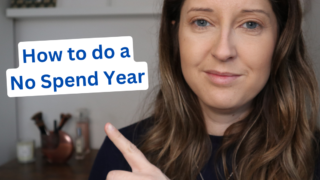Your cart is currently empty!

How To Do a No Spend Month or Year
& December/end of year review
It’s the end of the month and the end of my second no spend year. My first no spend year focused on clearing debt and this year the focus was on finding out more about myself, what I like and what I want to achieve with my money. It has had some ups and downs, but I definitely have come out of it with a stronger sense of what’s next for me financially.
How do you do a no spend month or year?
A no spend year is when you decide to limit how much you spend in different categories. This isn’t talking about essential bills. This is a surplus (left over) money after bills. I used to spend easily £400 a month on not a lot. I wouldn’t have been able to tell you what I had brought. It was a bit concerning to know that this one was being spent and I didn’t feel happy or content or like I had anything to show for it. That adds up to a lot of money over a year and this is where you can see what a big impact reducing spend can have.
There are a few steps you need to take in order to be successful…
- Know your why! This is going to keep you motivated. If you know you are clearing debt, saving for a house deposit or for your next holiday, this will fuel you to keep on track.
- Know your income and expenses. It is important to know exactly how much money is coming in and what bills are coming out.
- After bills, see if you can see what you are currently spending in each area such as travel, beauty, days out, homeware, etc. This is going to help you understand where you are spending your money and which areas are costing you the most.
- November: Little Acts of Decluttering
- Stop the CLUTTER!
- Declutter Before Christmas: 15 Must-Declutter Items
- October: Little Acts of Decluttering
- September: Little Acts of Decluttering
4. Now it is time to decide how much to spend in each category. This is your opportunity to set targets and goals that you think are achievable. Can you challenge yourself to spend nothing at all in some categories.
5. Reduce your food bill. One area of spend that is often a lot higher than necessary is food. It can be easy to get carried away with the food shop, add little extras each week or do additional trips to the shop that are unaccounted for. Reducing your food bill can give you some extra pennies in your pocket without missing out on good meals. What happened when we over purchase is that food becomes wasted and we don’t utilise what we have. Meal planning for the week or month gives you a clear list of ingredients you will need to purchase. You can also shop your cupboards first to see what you already have and avoid having a large back stock.
6. Set up sinking funds for known expenses that will come up. a sinking fund is a bank of money put aside for things that you know you will need to buy but are a bit more ad hoc. This includes things like birthdays, christmas, car MOT, etc. You know roughly how much you might spend across the year, so this could be put aside so that you have the money ready for when you need it. It saves the scramble to find money each money.
7. Talk to others about your no spend year plans. Opening up conversations can help them to see why you want to social in a different way that is cheap or free. They can also be a great source of emotional support.
For more information on how I got on with my no spend year, check out my video below!
Rachel, Declutter Your Life X
For little acts of decluttering… https://declutteryourlife.co.uk/minimalism/little-acts-of-decluttering/
January little acts of decluttering… https://declutteryourlife.co.uk/decluttering/january-little-acts-of-decluttering/
For more ideas, check out my youtube channel. https://www.youtube.com/c/RachelNoakes

Leave a Reply
You must be logged in to post a comment.